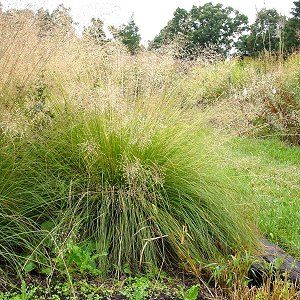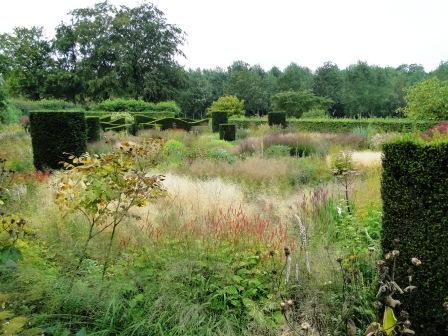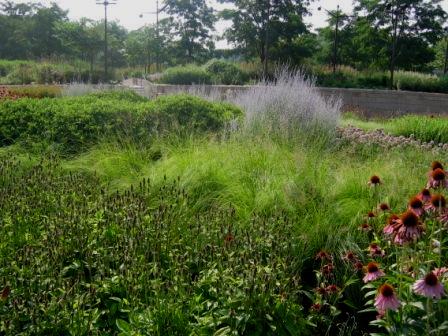I just returned home from my first trip to Europe. I was drawn to Grass Days at Kwekerij Oudolf, the home and nursery of influential Dutch garden designer and plantsman, Piet Oudolf and his wife Anja. I won’t elaborate on the Oudolf’s SPECTACULAR private garden in this post. I’ll save that for a later date. Oudolf’s work inspired September’s GGW Plant Pick of The Month, Prairie dropseed (Sporobolus heterolepis).

Image courtesy Northcreek Nurseries.
Prairie dropseed is undoubtedly one of my favorite grasses. It is a fine-textured bunchgrass, almost hair-like in appearance. Deep green leaves arch outward forming large round tufts (18″H x 24″ W). In fall, the foliage turns gold with orange tints and ultimately fades to bronze in winter.

Image courtesy Missouri Botanical Garden.
In August, open, branching flower panicles rise above the basal foliage on slender stems (reaching 36″ H). The pink and brown tinted flowers have a unique fragrance (said to be similar to coriander).
According to the Missouri Botanical Garden, where Sporobolus heterolepis has been named a Plant of Merit, dropseed may be started from seed but does not freely self seed in the garden. It is a slow growing and slow to establish grass. Therefore, I typically start with larger transplants.
This North American native has a widespread range. It is hardy in USDA zones 3-9. Dropseed is easily grown in average, well drained soils in full sun. The grass is tolerant of a wide range of soil types, including heavy clays and displays good drought tolerance once established.
In my opinion, dropseed looks best in a mass planting either as a monoculture or as the dominant plant in a matrix through which other plants emerge. Companions in a matrix planting include: early summer bulbs like Allium ‘Purple Sensation’ and plants with persistent seed heads such as Echinacea pallida, Liatris spicata, Sedum ‘Matrona’. Still other plants work well adjacent to large clumps of dropseed, including: Aster, Echinacea purpurea (cultivars), Perovskia atriplicifolia, Achillea, Echinops ritro, Baptisia ‘Purple Smoke’, Salvia, Nepeta ‘Walker’s Low’ to name just a few. Have you had success with other combinations? We’d love to hear about them.
If the species is too tall for your garden you’ll be happy to know plantsman, Roy Diblik of Northwind Perennial Farms introduced a dwarf cultivar, Sporobolus heterolepis ‘Tara’ to the trade. Diblik found the selection in 1994 in the Kettle Moraine in Wisconsin.
I saw a lovely combination planting at Midwest Groundcovers in Saint Charles, Illinois back in August including: Sporobolus heterolepis ‘Tara’, Amsonia hubrechtii, Allium ‘Summer Beauty’ (another Diblik introduction), Calamintha nepeta ssp. nepeta, Stachys officinalis ‘Hummelo’ and Limonium latifolium.
If this is your first time visiting GGW Plant Pick of The Month and you’d like to participate, simply post your comments below and a link to your own site where you’ve posted photos of Prairie dropseed and comments about your experience working with the grass, successful planting combinations, etc.


